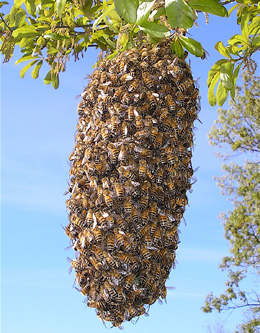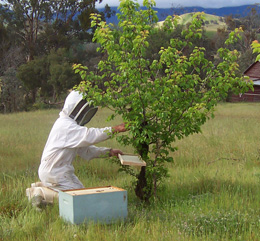Contact
Assistant Professor of Apiculture & Urban Entomology
Phone: 501-671-2222
Fax: 501-671-2252
Email: jzawislak@uada.edu
Web: uaex.uada.edu/bees
University of Arkansas System
Division of Agriculture
Cooperative Extension Service
2601 N. Young Ave.
Fayetteville, AR 72704
What is a Honey Bee Swarm?
Swarming is the reproduction of a honey bee colony. It is a normal and natural phenomenon, and rarely poses a danger to people or animals. When honey bees have good weather and plenty of food, their populations can increase dramatically.

When a colony becomes crowded inside their current home (a bee hive, hollow tree, or other cavity) they will begin to raise a new queen bee. When this new queen is almost mature, the old queen will leave the hive, followed by about one half or two-thirds of the worker bees and some of the drones. This queen bee will land nearby, on a tree, shrub, fence post or even a building. The worker bees cluster around the queen to protect her and keep her warm. Most of the cluster remains largely inactive, to conserve energy. However, a number of scout bees are sent out in all directions to search for another suitable home for their colony to move into. When a satisfactory site has been chosen, the entire swarm of bees will take to the air and move off to their new home. Once inside, the workers will begin to secrete beeswax, and build new combs for the queen to lay eggs and for the storage of honey.
Meanwhile, back in the old hive, a newly emerged queen bee will take a series of mating flights, then begin to head her inherited colony. She will never leave the hive again, unless she too leads a swarm to a new home. Soon after the new queen begins laying eggs, the population of bees in the original colony will begin to grow.
While the sudden appearance of a large number of honey bees may appear frightening to some people, they are usually quite harmless. Because they do not have any brood or honey to protect, a new swarm is usually very gentle in temperament and they rarely sting. Unless the swarm poses a specific threat or inconvenience to people, they can be left alone and admired from a distance. The bees will likely remain for only a few days at most, and then suddenly fly away to establish their new home.

Swarm Collection
A swarm of bees can often be easily moved. If the queen bee can be collected, most of the other bees will follow her into a new hive. Some beekeepers will be pleased to remove a swarm of bees from your property. But the bees may be located high in a tree, on a wall or some other inaccessible place which a beekeeper cannot easily reach them. Many beekeepers are not interested in collecting swarms, however, which are often too small to produce much honey, and because collecting the bees can sometimes involve a great deal of time and labor. Additionally, swarms of bees from unknown sources can have undesirable genetic dispositions, or can carry diseases, pests and parasites that may contaminate a beekeeper's other hives.
Report a Swarm of Honey Bees
If you have a honey bee swarm on your property and would like to have it removed, contact your local County Extension Office. A local beekeeper or beekeeping club may also be able to assist you. If you are a beekeeper and would like to have your name and contact information added to the swarm collection list, click the button below to fill out the form.
Feral Bee Colonies
Honey bees are not native to the Americas, but were brought here by European colonists in the 17th century. Bees were well-adapted for the climate in North America, and through the centuries many colonies have swarmed and set up their homes in hollow trees and other suitable cavities. For this reason, bee colonies not living in managed hives are considered to be feral, and not wild.
With the arrival of Africanized bees in Arkansas, some southern and western counties are under quarantine for moving honey bees. Small swarms of Africanized bees may appear to be gentle at first, but as the colony population increases, and the bees rear brood and collect a substantial amount of honey, their temperament may become increasingly defensive. For this reason, collecting swarms of bees in quarantined counties is not advised, and the destruction of the colony is often recommended. You may contact the Arkansas State Plant Board at 501-225-1598 to arrange for an apiary inspector to investigate swarms or feral bee colonies in trees or structures.
When a bee swarm finds an opening in the wall of a home or other structure, they may take up residence in the hollow space inside. These colonies can pose potential risks to residents, neighbors and pets, as well as cause damage to the structure and attract pests such as mice and other insects.
Attempting to kill a feral colony with insecticide is rarely a good solution.
The colony may be large, and located several feet away from the entrance where bees are seen entering a structure, and so they may not be significantly affected by the product. Also, if the bees are killed, the homeowner is left with thousands of dead bees rotting inside their walls. The unguarded nest that remains will become an attractive source of food for many other pests.
Removal of bees from a home can be a costly and time-consuming process depending on where the bees are located and how long the colony has been established. Each situation is unique. A local beekeeper may be willing to help you remove the bees, but a licensed contractor should be used if a significant amount of the structure must be dismantled and repaired. Because of the labor and liability involved with this type of work, many hobbyist beekeepers are reluctant to attempt these jobs, and homeowners may need to hire a professional pest control operator.
Professional Bee Removal Services in Arkansas
It is a violation of Arkansas state law to charge a fee for the removal honey bees from a structure without a valid pest control operator's license. For a current list of pest control operators who can remove honey bees from structures, contact the Apiary Section of the Arkansas Department of Agriculture at 501-225-1598.